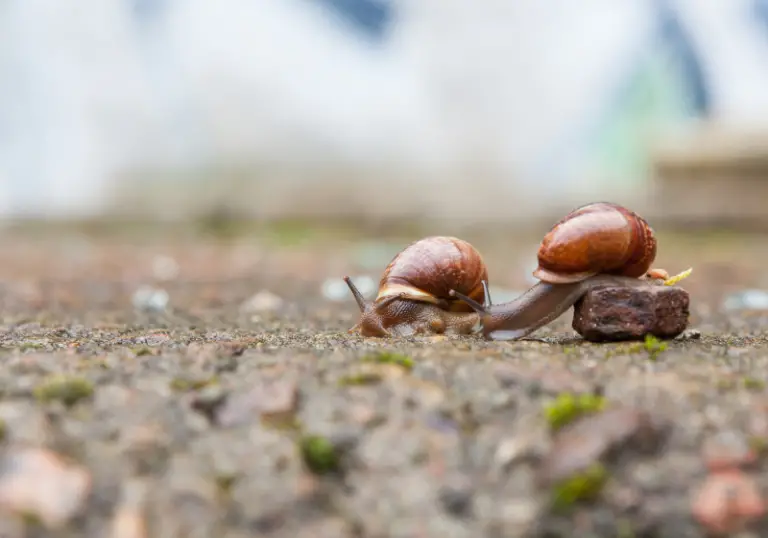Trochus Snails: Essential Facts for Aquarists

Trochus snails are fascinating marine invertebrates that bring vibrant colors to your aquarium and serve as efficient cleaners. These sea snails belong to Trochus and are among the aquarium hobby’s most popular and desired species. You’ll appreciate their striking appearance: their large, thick, solid shells with a broadly conical spire and a flat to convex base source.
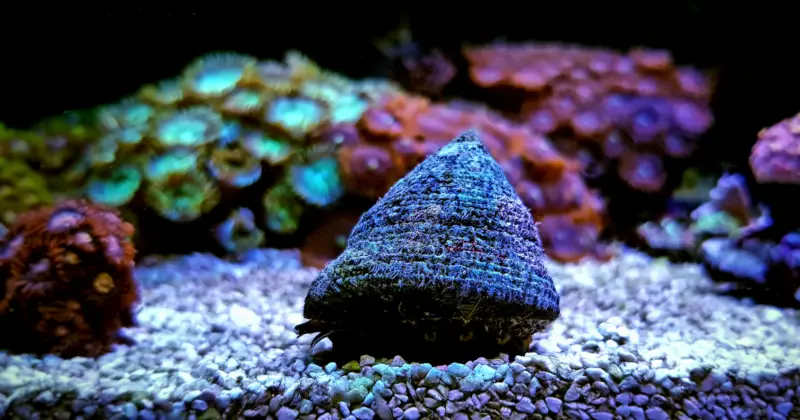
These peaceful creatures are reef-safe and compatible with corals, making them an excellent addition to your aquarium’s ecosystem. Trochus snails are easy to breed and care for, making them an attractive option for novice and experienced aquarium enthusiasts. Originating from the Indo-Pacific region, you can identify them by their distinctive cone-shaped shell and the unique banding patterns on some species, such as the Banded Trochus Snail source.
As you learn about trochus snails and their requirements, you’ll understand why they’re celebrated additions to marine aquariums. Offering both beauty and practicality, these snails will be a wonderful enhancement to your underwater world.
Contents
Table of Contents
Description and Anatomy
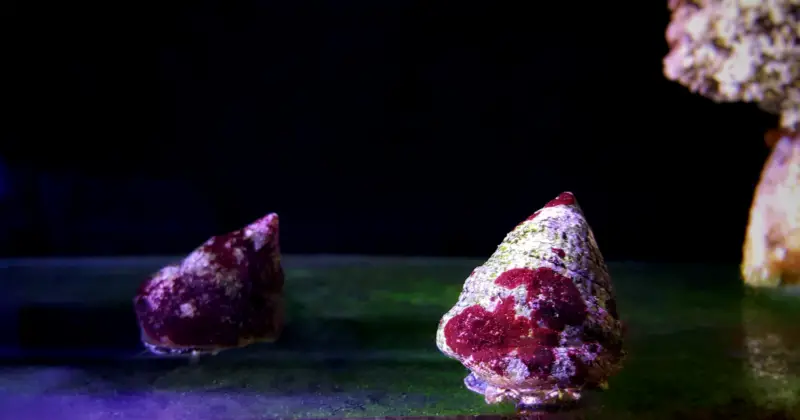
Trochus snails are known for their thick, solid shells with conical shapes. These shells can have various colors, such as creamy-white with reddish-brown patches, purplish, greenish, or brown, making them visually appealing for aquarium enthusiasts1. You’ll notice that the shell consists of up to 10 whorls, which spiral around the central axis of the spire1.
The base of their shell is almost flat, and in this region, you can find the operculum, a door-like structure that the snail uses to close its shell and protect itself from predators. Aside from the shell, trochus snails have soft bodies that include a muscular foot, which aids in movement, and two feelers that they use to sense their environment.
Regarding size, trochus snails can grow anywhere between 1 to 3 inches (2.5-7.6cm), depending on the species. These snails exhibit a neutral, herbivorous diet involving grazing on algae and biofilms found on rock surfaces. Moreover, they are commonly known as reef-safe invertebrates, making them an excellent choice for saltwater aquariums.
In summary, trochus snails can be a visually impressive and beneficial addition to your marine aquarium. Their unique shell structure and ability to help keep your tank clean make them an attractive and practical choice for any aquarist.
Varieties of Trochus Snails
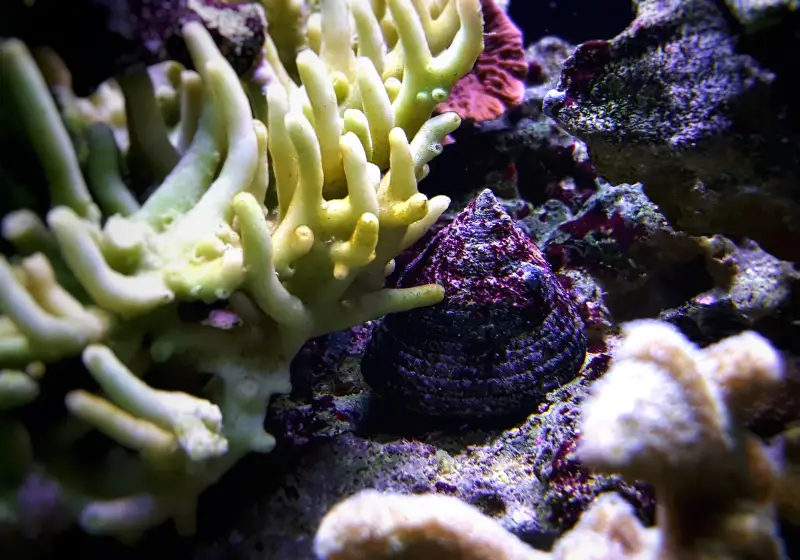
There are several species of Trochus snails, each with their unique characteristics. In this section, you’ll learn about some of the most common and popular varieties: Trochus maculatus, Trochus radiatus, Trochus histrio, Trochus noduliferus, Trochus niloticus, and Trochidae.
Trochus maculatus: Also known as the spotted top-shell snail, this species features a smooth shell with a conical spire and a flat to convex base. They are found in Southeastern Atlantic habitats, such as shallow waters near coral reefs, and prefer depths of less than 66 ft (20 meters).
Trochus radiatus: This variety is known for its distinctive radial pattern on the shell. They share the same habitat preferences as Trochus maculatus, living in shallow waters near coral reefs where algae and cyanobacteria thrive.
Trochus histrio: Like the previous two species, Trochus histrio resides in shallow waters near coral reefs. It is characterized by a more colorful and patterned shell, adding an aesthetic appeal to your aquarium.
Trochus noduliferus: This species has a thick, sturdy shell with a nodulated appearance. Like the other Trochus snails, it’s commonly found in shallow waters near coral reefs and prefers depths of less than 66 ft (20 meters).
Trochus niloticus: Also known as the commercial top shell, Trochus niloticus is characterized by a large, rounded shell with a flat base. It’s typically found in the Indo-Pacific region and is popular for its ornamental value in the aquarium hobby.
As members of the Trochidae family, all these Trochus snails share similar characteristics. They are all herbivores, feeding on algae and cyanobacteria, with varying life spans. While some species may live up to 15 years in the wild, in captivity, Trochus snails tend to live at least 2-3 years if appropriately cared for.
Natural Habitat and Origin
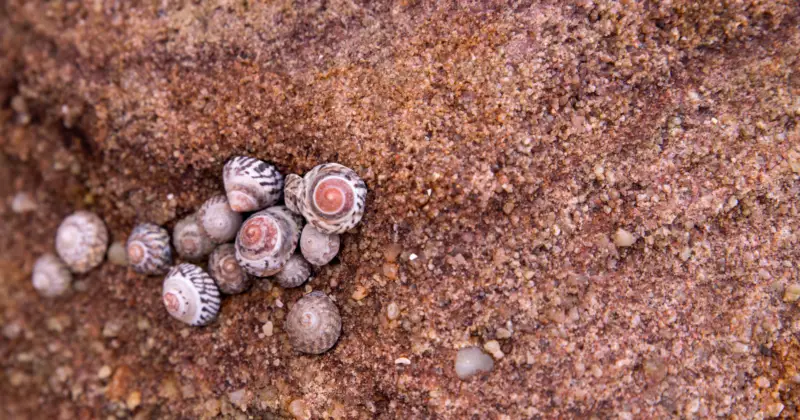
Trochus snails originate from the Indo-Pacific region, spanning a vast area that includes the Western Pacific, Southeast Asia, and Northern Australia. These marine creatures are commonly found in tropical waters, particularly in the Indian and Pacific Oceans. As a curious observer or an avid aquarist, you’ll appreciate their unique characteristics and role in maintaining a healthy marine ecosystem.
In their natural habitat, Trochus snails thrive in shallow waters near coral reefs, where algae and cyanobacteria are abundant. They prefer depths less than 66 ft (20 meters), making rocky shore areas a prime location for their presence.
These snails are typically found in the upper intertidal zone and inhabit areas close to coral formations on rocky shores. Their preferred environment in tropical waters offers ample opportunities to graze on algal films or macroscopic algae, contributing to a balanced ecosystem.
By understanding the native origin and natural habitat of Trochus snails, you can better appreciate their presence in your marine aquarium or when observing them in the wild. Remember that they favor intertidal zones, shallow waters, and coral reef environments throughout the Indo-Pacific region.
Similar conditions in your home aquarium will ensure their well-being and help maintain the ecological balance essential for a thriving marine community.
Behavior and Characteristics

Trochus snails are known for their thick, conical-shaped shells, often exhibiting various colors like creamy white, purplish, or greenish with brown patches. These sea snails can grow up to 2 inches in diameter. Their behavior and characteristics make them a popular choice for home aquariums.
A key trait of Trochus snails is their peaceful and non-aggressive nature. They are solitary creatures, unable to attack other aquarium inhabitants. Instead, they rely on their shell and operculum for protection. This makes them suitable for a calm aquatic environment with like-minded tank mates.
These snails are nocturnal creatures, becoming active during the night hours. They crawl around, feeding on algae and other organic matter. It’s crucial to keep stress levels low for Trochus snails, as it can affect their overall well-being.
One common issue you might face with Trochus snails is their inability to flip themselves back to their original position if they accidentally fall or get knocked over. This could be potentially dangerous for the snail, as it might lead to a lack of access to food or increased vulnerability to predators. However, you can gently help them by putting a finger under their shell and guiding them back into the right position.
In summary, Trochus snails are peaceful, non-aggressive, and nocturnal creatures that prefer a calm aquatic environment. Keep stress levels low, maintain a suitable habitat, and ensure they are correctly positioned to aid their feeding and protection.
Diet and Algae Consumption
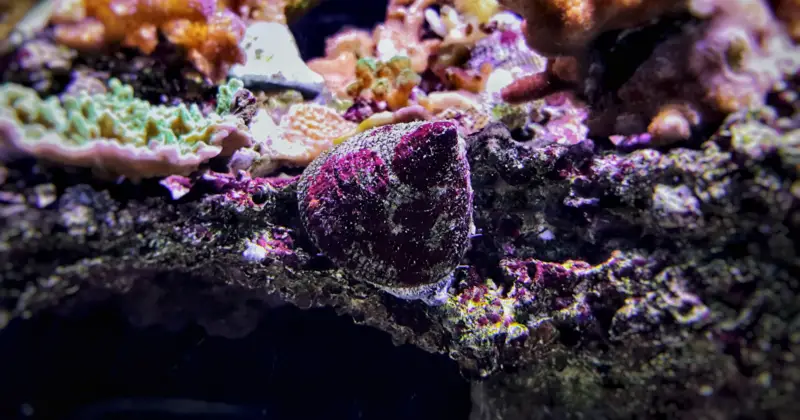
As a Trochus snail owner, you will find these creatures to be efficient and effective algae eaters in your aquarium. Being herbivores, their primary diet consists of different types of algae, making them a valuable addition when it comes to controlling excess and nuisance algae.
One of the key benefits of having trochus snails in your tank is their ability to consume a wide variety of algae, including diatoms, cyanobacteria, hair algae, and film algae. They are especially known for their appetite for diatoms and can effectively handle this common issue in new aquariums.
Cyanobacteria, which can form unsightly mats in your tank, is another type of algae that trochus snails can help eliminate. Similarly, they can tackle hair algae, which often grows on rocks and aquarium decorations, restoring the appearance of your aquatic environment.
Let’s not forget about film algae, either. As diligent herbivores, trochus snails are great at removing this thin algae layer that tends to cover glass and other surfaces, making your tank appear dirty and unkempt.
To ensure the well-being of your trochus snails and maintain their efficacy as algae-eaters, it is crucial to keep their environment stable. This means maintaining water conditions of 74-79°F (23-26°C) and a pH of 8.1 – 8.4, with medium to dim lighting in a minimum 10-gallon (38-liter) tank with non-aggressive tank mates.
However, in cases where your snails completely decimate the existing algae, you should occasionally supplement their diet with algae wafers or other herbivore-safe food. This can be done by dropping a wafer or two into the tank during the evening, as trochus snails are typically more active at night. Remember to monitor your snails’ consumption to ensure they are well-fed and thriving in your aquarium.
Role in Aquariums

As an aquarium enthusiast, you might consider adding Trochus snails to your saltwater aquarium or reef tank. These hardworking creatures play a significant role in maintaining a healthy environment for your aquatic inhabitants.
One major benefit of having Trochus snails in your aquarium is their ability to control algae growth. They achieve this by using their radula, a ribbon-like structure lined with small teeth, to scrape algae off rocks, glass surfaces, and other areas in your tank. This characteristic makes them an optimal choice for maintaining the cleanliness of your saltwater aquarium.
Trochus snails are reef-safe, meaning they will not cause harm to your live rock or other delicate components of a reef tank. Furthermore, these snails can coexist with non-aggressive tank mates, creating a harmonious environment for all aquatic pets.
When considering tank size, it’s essential to ensure you provide adequate space for Trochus snails to thrive. A minimum 10-gallon (38-liter) tank is recommended for their optimal well-being. Be sure to maintain ideal water conditions of 74-79°F (23-26°C), a pH of 8.1 – 8.4, and medium to dim lighting to support their health and growth.
In addition to keeping your aquarium clean and algae-free, Trochus snails are attractive creatures that add an aesthetic appeal to your scenery. With proper care and an understanding of their needs, you might even be able to breed Trochus snails in your saltwater aquarium to enhance its composition further.
In conclusion, having Trochus snails in your aquarium or reef tank not only aids in keeping it clean but also contributes to a visually appealing and harmonious environment. By considering their ideal living conditions and ensuring they are compatible with your other aquatic creatures, Trochus snails are a valuable addition to your aquatic ecosystem.
Breeding and Lifespan

Trochus snails have a relatively long lifespan for their size. Some species are reported to live up to 15 years, but in captivity, they generally live for at least 2 to 3 years when properly cared for. As larger snails, they tend to have a longer lifespan compared to other snails.
When it comes to breeding, Trochus snails can successfully reproduce in a well-maintained aquarium environment. They are known to breed quite easily, and you may find yourself surprised and happy to discover baby Trochus snails in your tank.
The breeding process for these snails is straightforward. The adult snails release eggs and sperm into the water column, where fertilization occurs. Afterward, the fertilized eggs develop into larvae, a crucial stage in their life cycle. The larval stage requires proper water conditions and an abundance of food to grow and develop into fully-formed snails.
To ensure successful breeding and larval development, maintain appropriate water conditions for your Trochus snails. Keep the water temperature between 74-79°F (23-26°C), with a pH of 8.1-8.4, and medium to dim lighting 2. Additionally, providing enough algae for them to graze, as they are herbivorous, will help maintain their health and encourage reproduction.
By understanding and maintaining proper care for your Trochus snails, you can help them thrive in your aquarium and possibly even assist them in passing on their beneficial traits to the next generation.
Caring for Trochus Snails
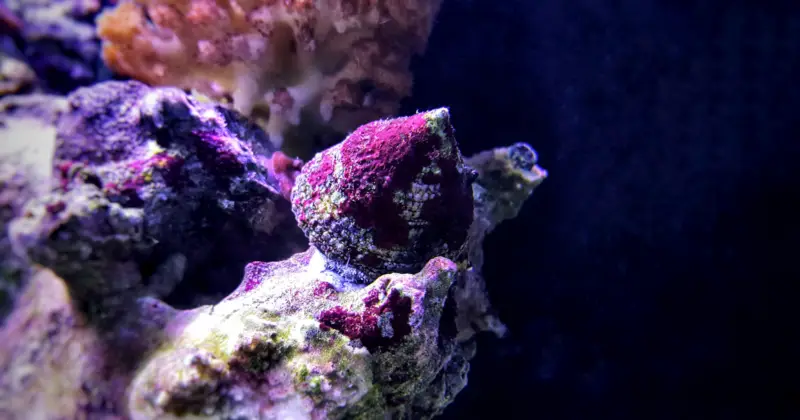
Due to their low maintenance and cleaning abilities, Trochus snails are popular among aquarium enthusiasts. As invertebrates, they help maintain a healthy aquatic environment by feeding on algae and detritus. This section will guide you on properly caring for these useful creatures.
First and foremost, it is crucial to maintain an environment suitable for Trochus snails. They thrive in water conditions between 74-79°F (23-26°C) and a pH of 8.1 – 8.4. Regular monitoring and water changes are essential to keep the water parameters stable. They prefer medium to dim lighting conditions conducive to the growth of the algae they feed on.
When introducing Trochus snails into your aquarium, it is important to reduce their stress levels with a proper acclimation process. Slowly acclimate them by adding small amounts of your tank’s water to their temporary container over an hour or two. This will help them adjust to the new conditions and minimize the risk of shock.
One of the benefits of Trochus snails is that they are generally easy to care for. They are primarily herbivores, so their primary source of nutrition comes from the algae in your tank. If you notice a shortage of algae, you may need to supplement their diet with algae wafers or tablets to ensure they are properly nourished.
Creating a comfortable environment for your Trochus snails within your aquarium is important. This can include providing hiding spaces, such as rocks and live plants, to help them feel secure. Be mindful of their tank mates, ensuring they are non-aggressive species that can coexist peacefully with the snails.
It’s also important to keep track of your snails’ population. The appropriate number of snails per gallon of water is key for effective algae control and maintaining a balanced ecosystem. A general guideline is to have one to five Trochus snails per gallon of tank volume, but this can vary based on factors such as the amount of algae present and the desired cleanup speed.
By following these guidelines, you can provide a hospitable environment for your Trochus snails, allowing them to maintain your aquarium and thrive in their new home efficiently.
Species Spotlight | Trochus Snail
Potential Threats
As an owner of Trochus snails, being aware of potential threats is essential for a thriving tank environment. With their exceptional algae-eating capabilities, these snails are a valuable addition to your aquarium. Let’s discuss some challenges they might face.
One crucial factor to consider is your snails’ predators. Some aggressive and carnivorous fish such as triggerfish, wrasses, and pufferfish, can see Trochus snails as a meal. To avoid this problem, choose non-aggressive tank mates that won’t harm your snails.
The aquarium’s environment plays a significant role in your snails’ health. Rocks can be both beneficial and harmful to them. While they need rocks and other surfaces to graze on, sharp rocks can injure Trochus snails. Make sure to provide them with smooth, safe surfaces to crawl on.
Water conditions also affect the well-being of your snails. A proper pH range of 8.1 – 8.4 is crucial in maintaining their health. Regularly monitor and adjust your tank’s pH levels to stay within this range. If the pH is outside this range, it may cause your snails to become stressed and vulnerable to diseases.
Lighting is another important factor to consider. Trochus snails can thrive in medium to dim lighting, as mentioned in this guide. Extremely bright lighting can disturb their natural behavior and stress them out. Ensure you maintain suitable lighting conditions for them to continue feeding on algae comfortably.
Water quality is also vital for your Trochus snails. High nitrate levels in the water can negatively impact their health, leading to reduced activity and potential death. Make sure to test your nitrate levels frequently and perform water changes as needed to provide a safe and clean environment for your snails.
Addressing these potential threats will create a secure and thriving environment for your Trochus snails, allowing them to help maintain a clean and healthy aquarium effectively.
Comparison with Other Snails

Regarding saltwater aquariums, Trochus snails are known for being efficient algae-eaters. Still, other popular alternatives include Cerith snails, Turbo snails, Turban snails, Top snails, Astrea snails, and Tectus snails. Each of these snail species has unique characteristics, so it is essential to understand their differences to pick the most suitable option for your aquarium.
Cerith snails are known for their slender, elongated shells and ability to reach into small crevices to consume algae and detritus. They are also beneficial for controlling diatom and cyanobacteria growth. Compared to Trochus snails, Cerith snails are better suited for handling sand substrate due to their burrowing abilities.
Turbo snails, like Trochus snails, are excellent algae grazers. However, their larger size can make them less agile and prone to knocking over delicate aquarium structures. It is vital to consider your tank’s size and aquascape before introducing Turbo snails, as they may need more space to move around.
Turban snails are another popular algae-eating species with their conical shell shape. While they are efficient grazers like Trochus snails, Turban snails tend to be slower and vulnerable to predation. However, they typically have a longer lifespan, making them a reliable addition to your clean-up crew.
When it comes to Top snails these are known for their unique appearance, often having spotted or banded shells. They are diligent algae eaters like Trochus snails but may have specific care requirements due to their sensitivity to changes in water parameters.
Astrea snails are often compared to Trochus snails because of their similar diet and behavior. However, Astrea snails have a flat, conical shell and are known for having difficulty righting themselves if they fall on their backs. This disadvantage can lead to premature death, making them a less robust option than Trochus snails for aquarium owners who prioritize low-maintenance snails.
Lastly, Tectus snails have a thick, cone-shaped shell and are also efficient algae grazers. They usually appear similar to Trochus snails but may be more resilient and adaptable to varying water conditions.
In summary, Trochus snails and their alternatives each bring unique benefits and challenges to your marine aquarium. Consider your tank size, aquascape, and maintenance preferences to find the snail species that best support your saltwater environment.
Identifying Trochus Snails
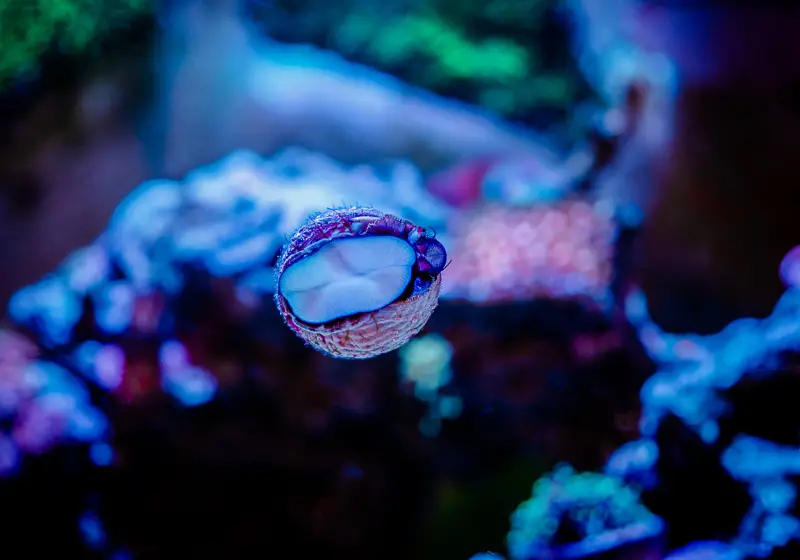
When you come across a snail in your aquarium or the wild, you may wonder if it’s a Trochus snail. Pay close attention to their shells, tentacles, and feet to identify these fascinating creatures. Trochus snails, also known as top shell snails, have unique features that set them apart from other snails.
First, examine the snail’s shell. Trochus snails have thick, solid shells with conical shapes [source]. Their shells are almost flat at the base and have up to 10 whorls. You may also notice narrow, horizontally inclined radiating lines on their shells, which earned them the nickname “branded top snails” [source]. These snails display various shell colors, including creamy-white with reddish-brown patches, purplish, greenish, or brown [source].
Next, observe the snail’s tentacles and feet. Trochus snails possess two tentacles and a distinctive black foot. This feature separates them from other snails and can help you identify a specific species, such as the black foot Trochus. Some varieties, like the banded Trochus snail, have a particularly eye-catching foot color pattern; their foot has alternating stripes of black and white or another shade [source].
In addition to their physical features, Trochus snails are known for their beneficial ora with corals. They often live in coral reefs and can even help clean your aquarium by consuming algae [source]. Paying attention to their surroundings and behaviors can also assist you in confirming their identity.
By examining their shells, tentacles, and feet and observing their natural habitat and interactions with corals, you can confidently identify Trochus snails and appreciate their unique beauty to the underwater world.
Other Relevant Information

Trochus snails, belonging to the Trochidae family, are popular marine invertebrates often included in reef aquariums as part of the clean-up crew. They are known for their beautiful shells and efficient algae-grazing abilities.
Most Trochus species grow to a maximum size of around 1-3 inches (2.5-7.6cm). These snails are reef-safe and compatible with corals, making them a great addition to your aquarium. They thrive in natural habitats like the Indo-Pacific region but can easily adapt to a well-maintained tank setup.
As herbivorous creatures, Trochus snails primarily feed on algae and detritus, helping to maintain a clean and healthy aquatic environment. They can effectively reduce nitrate levels in your aquarium by consuming excess algae. To keep these snails happy, provide them with plenty of rocks and hiding spots to emulate their natural habitat.
When adding Trochus snails to your aquarium, consider their tank mates. They coexist well with non-aggressive species and are generally low maintenance, requiring only stable water conditions and a proper diet. Their ideal water temperature ranges between 74-79°F (23-26°C) with a pH of 8.1 – 8.4.
Trochus snails are an excellent addition to your reef aquarium, thanks to their algae-eating abilities and compatibility with various aquatic species. Remember to provide appropriate living conditions, including proper water temperature and rocks, to promote a thriving and healthy environment in your tank.
Frequently Asked Questions
How long do Trochus snails live?
Trochus snails can live for several years, depending on tank conditions and diet. To maximize their lifespan, it’s important to maintain a stable aquatic environment with appropriate water conditions and provide them with a consistent algae source.
Do Trochus snails reproduce in aquariums?
Yes, Trochus snails can reproduce in aquariums, albeit slowly. They are known to be broadcast spawners, releasing sperm and eggs into the water. If the conditions are right and the eggs are fertilized, they will develop into larvae before settling down and transforming into juvenile snails.
Can Trochus snails right themselves?
Trochus snails are generally good at righting themselves if they happen to fall onto their backs. However, it’s essential not to overcrowd your tank or add too many rocks, as this might increase the chances of a snail getting stuck and being unable to right itself.
What do Trochus snails eat?
Trochus snails are herbivorous and primarily graze on algae and detritus in your aquarium. They help keep tanks clean by consuming various types of algae, such as diatoms, hair algae, and film algae. Providing enough algae or substituting with algae wafers is important if natural algae growth is low in the tank.
Trochus snail vs. Turbo snail: Which is better?
Trochus and Turbo snails are popular cleanup crew members due to their algae-eating abilities. However, there are differences between the two. Trochus snails are generally better at controlling algae in smaller tanks, as they are smaller and less likely to knock over corals or decorations.
Turbo snails are larger and can be more effective in larger tanks with significant algae problems. It’s important to consider your specific needs and tank conditions when choosing between these two snail types.
How many Trochus snails should be in a tank?
The number of Trochus snails you should keep in your tank can depend on the size of your aquarium and the amount of algae present. Generally, having one Trochus snail per 2-3 gallons of water is recommended. This ensures that the snails have enough space to move comfortably and enough food to sustain them while keeping your tank clean.

![Do Snails Change Shells? [Full Guide]](https://allourcreatures.com/wp-content/uploads/2021/11/snails-and-shell-768x511.jpg)
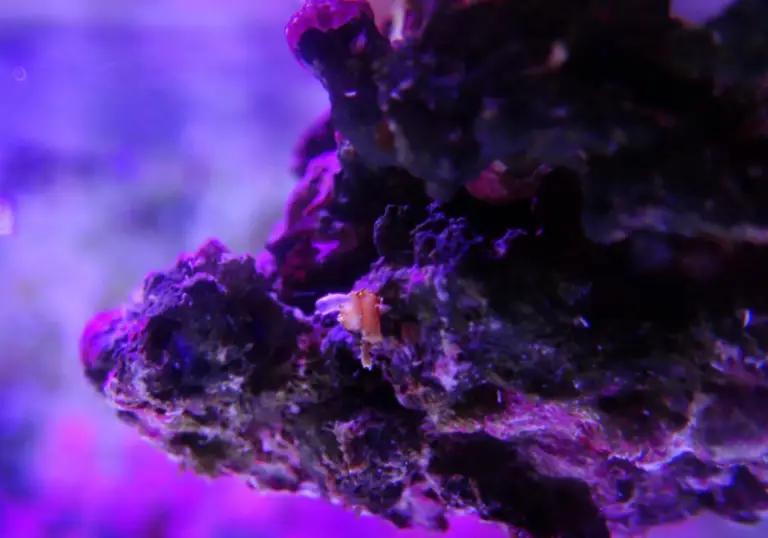
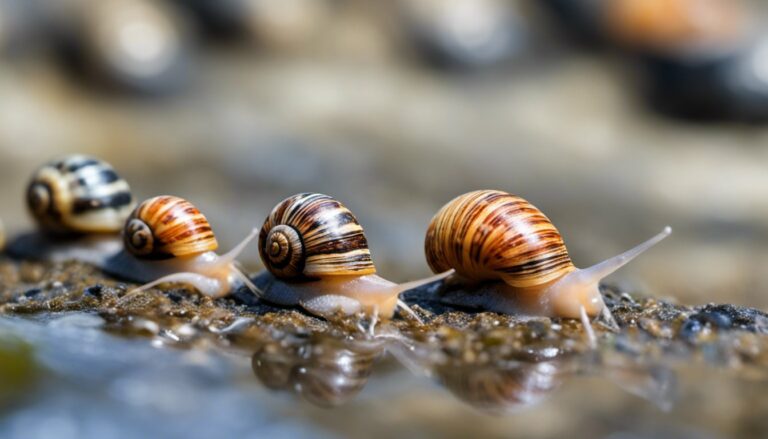
![Do Snails Need Water? [Complete Guide]](https://allourcreatures.com/wp-content/uploads/2021/11/do-snails-need-water-768x513.jpg)
![Do Snails Have A Foot? [Full Guide]](https://allourcreatures.com/wp-content/uploads/2021/11/snail-foot-768x577.jpg)
